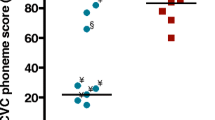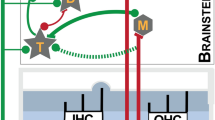Abstract
Individuals with sudden unilateral deafness offer a unique opportunity to study plasticity of the binaural auditory system in adult humans. Stimulation of the intact ear results in increased activity in the auditory cortex. However, there are no reports of changes at sub-cortical levels in humans. Therefore, the aim of the present study was to investigate changes in sub-cortical activity immediately before and after the onset of surgically induced unilateral deafness in adult humans. Click-evoked auditory brainstem responses (ABRs) to stimulation of the healthy ear were recorded from ten adults during the course of translabyrinthine surgery for the removal of a unilateral acoustic neuroma. This surgical technique always results in abrupt deafferentation of the affected ear. The results revealed a rapid (within minutes) reduction in latency of wave V (mean pre = 6.55 ms; mean post = 6.15 ms; p < 0.001). A latency reduction was also observed for wave III (mean pre = 4.40 ms; mean post = 4.13 ms; p < 0.001). These reductions in response latency are consistent with functional changes including disinhibition or/and more rapid intra-cellular signalling affecting binaurally sensitive neurons in the central auditory system. The results are highly relevant for improved understanding of putative physiological mechanisms underlying perceptual disorders such as tinnitus and hyperacusis.




Similar content being viewed by others
References
Adams JC (1979) Ascending projections to the inferior colliculus. J Comp Neurol 183:519–538
Adjamian P, Sereda M, Hall DA (2009) The mechanisms of tinnitus: perspectives from human functional neuroimaging. Hear Res 253:15–31
Baguley DM (2002) Mechanisms of tinnitus. Br Med Bull 63:195–212
Baguley DM, Moffatt DA, Hardy DG (1992) J Laryngol Otol 106:329–331
Bilecen D, Seifritz E, Radu EW, Schmid N, Wetzel S, Probst R, Scheffler K (2000) Cortical reorganization after acute unilateral hearing loss traced by fMRI. Neurology 54:765–767
Bridger MW, Graham JM (1985) The influence of raised body temperature on auditory evoked brainstem responses. Clin Otolaryngol Allied Sci 10:195–199
Buonomano DV, Merzenich MM (1998) Cortical plasticity: from synapses to maps. Annu Rev Neurosci 21:149–186
Burkard RF, Don M (2007) The auditory brainstem response. In: Burkard RF, Don M, Eggermont JJ (eds) Auditory evoked potentials: basic principles and clinical application. Lippincott Williams and Wilkins, Philadephia, pp 229–253
Coleman JR, Clerici WJ (1987) Sources of projections to subdivisions of the inferior colliculus in the rat. J Comp Neurol 262:215–226
Davis A, Rafaie E (2000) Epidemiology of tinnitus. In: Tyler (ed) Tinnitus handbook. Singular, San Diego, pp 1–24
Deans JA, Birchall JP, Mendelow AD (1990) Acoustic neuroma and the contralateral ear: recovery of auditory brainstem response abnormalities after surgery. J Laryngol Otol 104:565–569
Elberling C, Don M (1984) Quality estimation of averaged auditory brainstem responses. Scand Audiol 13:187–197
Fahy C, Nikolopoulos TP, O’Donoghue GM (2002) Acoustic neuroma surgery and tinnitus. Eur Arch Otolaryngol 259:299–301
Firszt JB, Ulmer JL, Gaggl W (2006) Differential representation of speech sounds in the human cerebral hemispheres. Anat Rec A: Discov Mol Cell Evol Biol 288:345–357
Grabel JC, Zappulla RA, Ryder J, Wang WJ, Malis LI (1991) Brain-stem auditory evoked responses in 56 patients with acoustic neurinoma. J Neurosurg 74:749–753
Gu JW, Halpin CF, Nam EC, Levine RA, Melcher JR (2010) Tinnitus, diminished sound-level tolerance, and elevated auditory activity in humans with clinically normal hearing sensitivity. J Neurophysiol 104:3361–3370
Gu JW, Herrmann BS, Levine RA, Melcher JR (2012) Brainstem auditory evoked potentials suggest a role for the ventral cochlear nucleus in tinnitus. J Assoc Res Otolaryngol 13:819–833
Guimaraes AR, Melcher JR, Talavage TM, Baker JR, Ledden P, Rosen BR, Kiang NY, Fullerton BC, Weisskoff RM (1998) Imaging subcortical auditory activity in humans. Hum Brain Mapp 6:33–41
Irvine DRF (2010) Plasticity in the auditory pathway. In: Rees A, Palmer AR (eds) The Oxford handbook of auditory science: the auditory brain. Oxford University Press, Oxford, pp 387–415
Kaltenbach JA (2011) Tinnitus: models and mechanisms. Hear Res 276:52–60
Langers DR, van Dijk P, Backes WH (2005) Lateralization, connectivity and plasticity in the human central auditory system. Neuroimage 28:490–499
Legatt AD (2002) Mechanisms of intraoperative brainstem auditory evoked potential changes. J Clin Neurophysiol 19:396–408
Leonetti JP, Marzo SJ (1999) Translabyrinthine approach. Oper Tech Neurosurg 2:52–57
Levine RA (1981) Binaural interaction in brainstem potentials of human subjects. Ann Neurol 9:384–393
Markand ON, Lee BI, Warren C, Stoelting RK, King RD, Brown JW, Mahomed Y (1987) Effects of hypothermia on brainstem auditory evoked potentials in humans. Ann Neurol 22:507–513
Maslin MR, Munro KJ, El-Deredy W (2013a) Source analysis reveals plasticity in the auditory cortex: evidence for reduced hemispheric asymmetries following unilateral deafness. Clin Neurophysiol 124:391–399
Maslin MR, Munro KJ, El-Deredy W (2013b) Evidence for multiple mechanisms of cortical plasticity: a study of humans with late-onset profound unilateral deafness. Clin Neurophysiol 124:1414–1421
McAlpine D, Martin RL, Mossop JE, Moore DR (1997) Response properties of neurons in the inferior colliculus of the monaurally deafened ferret to acoustic stimulation of the intact ear. J Neurophysiol 78:767–779
Moffat DA, Baguley DM, Hardy DG, Tsui YN (1989) Contralateral auditory brainstem response abnormalities in acoustic neuroma. J Laryngol Otol 103:835–838
Moller AR (2010) Intraoperative neurophysiological monitoring, 3rd edn. Springer, New York
Moller AR, Jannetta PJ (1981) Compound action potentials recorded intracranially from the auditory nerve in man. Exp Neurol 74:862–874
Moore DR (1994) Auditory brainstem of the ferret: long survival following cochlear removal progressively changes projections from the cochlear nucleus to the inferior colliculus. J Comp Neurol 339:301–310
Moore DR, King AJ (2004) Plasticity of binaural systems. In: Parks TN, Rubel EW, Fay RR, Popper AN (eds) Springer handbook of auditory research. Springer-Verlag, New York, pp 96–172
Mossop JE, Wilson MJ, Caspary DM, Moore DR (2000) Down-regulation of inhibition following unilateral deafening. Hear Res 147:183–187
Norena AJ, Eggermont JJ (2003) Changes in spontaneous neural activity immediately after an acoustic trauma: implications for neural correlates of tinnitus. Hear Res 183:137–153
Ponton CW, Vasama JP, Tremblay K, Khosla D, Kwong B, Don M (2001) Plasticity in the adult human central auditory system: evidence from late-onset profound unilateral deafness. Hear Res 154:32–44
Popelar J, Erre JP, Aran JM, Cazals Y (1994) Plastic changes in ipsi-contralateral differences of auditory cortex and inferior colliculus evoked potentials after injury to one ear in the adult guinea pig. Hear Res 72:125–134
Ramsden RT (1995) The bloody angle: 100 years of acoustic neuroma surgery. J R Soc Med 88:464P–468P
Rauschecker JP (1999) Auditory cortical plasticity: a comparison with other sensory systems. Trends Neurosci 22:74–80
Salvi RJ, Wang J, Ding D (2000) Auditory plasticity and hyperactivity following cochlear damage. Hear Res 147:261–274
Schaette R, McAlpine D (2011) Tinnitus with a normal audiogram: physiological evidence for hidden hearing loss and computational model. J Neurosci 31:13452–13457
Scheffler K, Bilecen D, Schmid N, Tschopp K, Seelig J (1998) Auditory cortical responses in hearing subjects and unilateral deaf patients as detected by functional magnetic resonance imaging. Cereb Cortex 8:156–163
Selters WA, Brackmann DE (1977) Acoustic tumor detection with brain stem electric response audiometry. Arch Otolaryngol 103:181–187
Stockard JJ, Sharbrough FW, Tinker JA (1978) Effects of hypothermia on the human brainstem auditory response. Ann Neurol 3:368–370
Thai-Van H (2013) Unilateral deafness: a unique model for the investigation of functional plasticity mechanisms in the human auditory cortex. Clin Neurophysiol 124:1267–1268
Torossian A (2008) Thermal management during anaesthesia and thermoregulation standards for the prevention of inadvertent perioperative hypothermia. Best Pract Res Clin Anaesthesiol 22:659–668
Vasama JP, Marttila T, Lahin T, Makela JP (2001) Auditory pathway function after vestibular schwannoma surgery. Acta Otolaryngol 121:378–383
Woolf CJ, Salter MW (2000) Neuronal plasticity: increasing the gain in pain. Science 288:1765–1769
Zeng FG (2013) An active loudness model suggesting tinnitus as increased central noise and hyperacusis as increased nonlinear gain. Hear Res 295:172–179
Author information
Authors and Affiliations
Corresponding author
Rights and permissions
About this article
Cite this article
Maslin, M.R.D., Lloyd, S.K., Rutherford, S. et al. Rapid Increase in Neural Conduction Time in the Adult Human Auditory Brainstem Following Sudden Unilateral Deafness. JARO 16, 631–640 (2015). https://doi.org/10.1007/s10162-015-0526-8
Received:
Accepted:
Published:
Issue Date:
DOI: https://doi.org/10.1007/s10162-015-0526-8




